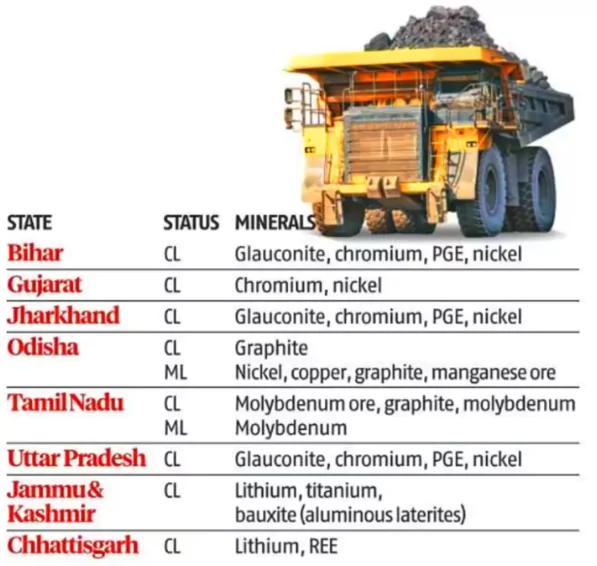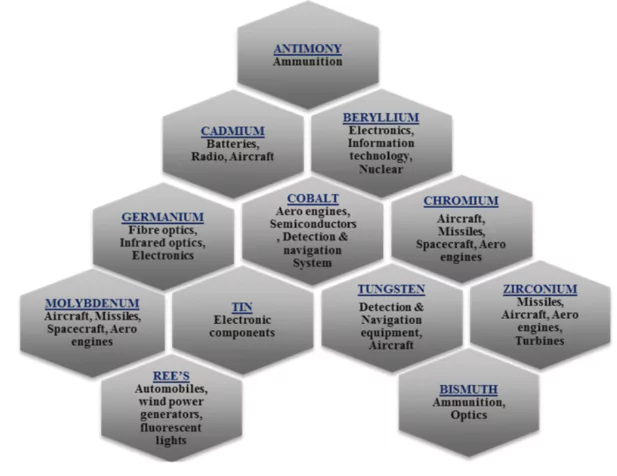Context:
Recently the Cabinet has specified the royalty rate for 12 critical minerals, which primarily include beryllium, cadmium, cobalt, gallium, indium, rhenium, selenium, tantalum, tellurium, titanium, tungsten and vanadium.
What are Critical Minerals? – A Spotlight on Critical Minerals

- These minerals are necessary for national security, economic growth, and renewable energy.
- The development of numerous industries, such as high-tech electronics, telecommunications, transportation, and defence, depends on these.
- Identified Critical Minerals: The Expert Committee under the Ministry of Mines has identified a set of 30 critical minerals for India.
-
- These are Antimony, Beryllium, Bismuth, Cobalt, Copper, Gallium, Germanium, Graphite, Hafnium, Indium, Lithium, Molybdenum, Niobium, Nickel, PGE, Phosphorous, Potash, REE, Rhenium, Silicon, Strontium, Tantalum, Tellurium, Tin, Titanium, Tungsten, Vanadium, Zirconium, Selenium, and Cadmium.
What are Royalty Rates? Payments for Resource Extraction and Mineral Rights Under MMDRA 1957
- Fees paid to the government for the removal of resources or minerals from a designated area are known as royalty rates.
- MMDRA 1957’s second schedule addresses mineral royalty rates.
- These minerals have been removed from the list of atomic minerals, and the commercial sector is now able to bid for them.
Key Features of Mines and Minerals (Development and Regulation) Amendment Act 2023:
| Provision |
Mines and Minerals (Development and Regulation) Act, 1957 |
Mines and Minerals (Development and Regulation) Amendment Act, 2023 |
| Exploration License for Specified Minerals: |
The Seventh Schedule lists 29 minerals, including gold, silver, copper, cobalt, nickel, lead, potash, and rock phosphate, for which an exploration license will be granted.
The following minerals are categorized as atomic minerals by it:
- Beryllium and beryl
- Niobium lithium
- Titanium
- Zirconium tantallium.
|
- The Act removes minerals such as beryllium and beryl, lithium, niobium, titanium, tantallium, and zirconium from the list of atomic minerals.
- Mining and exploration of these minerals will be available to the private sector once they are removed from the list of atomic minerals.
|
| Validity of Exploration License: |
NIL |
- The five-year license for exploration will be granted.
|
| Auction of Certain minerals by the Central Government: |
- Except in a few specific circumstances, state governments are responsible for conducting concession auctions under the Act.
|
- The Act further states that the union government would hold an auction for composite licenses and mining leases for specific important and strategic minerals.
- Lithium, cobalt, nickel, phosphate, potash, tin, and phosphate are some of these minerals.
|
| The incentive for exploration licencee: |
NIL |
- Within six months of the exploration licensee’s report submission, the state government must hold a mining lease auction if the resources are confirmed through exploration. A portion of the mining lease auction proceeds for the mineral that the licensee has prospected will be awarded to them.
|
Exploring Critical Mineral Uses and Estimated Reserves in India

Estimated Reserves
- Lithium Reserve: J&K and Chhattisgarh’s lithium reserves are being auctioned out for a CL.
- J&K Block: This block has an estimated resource of 5.9 million metric tonnes (mt) of bauxite column, which includes more than 70,000 tonnes of titanium metal and 3,400 tonnes of lithium metal.
- Odisha Block: The inferred value is 3,908 tonnes of nickel metal content or 2.05 million tonnes of nickel ore.
- The only block with copper reserves is the Odisha block.
|
News Source: PIB
![]() 1 Mar 2024
1 Mar 2024

